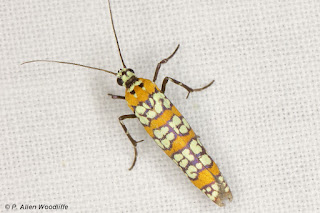The title of this post may lead one to think about Common Nighthawk, Eastern Whip-poor-will, Chimney Swift, Eastern Screech Owl, Virginia Opossums and such. I do not have much of a photo stock of such creatures for the most part, but there are night-time creatures that I have lots of photos of.
So I'm taking a break in my blog posts, from the usual birds and plants theme. With the periodic and sporadic unseasonable warmth over the last couple of months, I decided to put up the black light in the yard to see what creatures might be lured in. While it has been tempting to set up at Rondeau, being a sandspit surrounded by the cooler waters of Lake Erie in spring time results in the overall, and especially the night-time, temperatures to be less than ideal, especially if the all too often east to north-east winds are present. Hopefully in the next week or so, I will resume black lighting at Rondeau. In the meantime, I will feature a few of the more interesting ones that have shown up in my yard.
One of the more colourful ones that shows up in a variety of settings is this first one, the Ailanthus Webworm Moth.
Belted Leafroller, next, has some look-alike relatives, and one has to carefully examine the pattern to be sure.....
.....and the grass-veneer group also has subtle differences amongst the species. I am fairly certain that this next one is a Bluegrass Grass-veneer.
A quite regular visitor to black lights is this next one, the Bristly Cutworm.
I have photographed this next species, the Broken-banded Leafroller, on several occasions in the past, but never in my yard.
The Codling Moth, next, can be a problem for some fruit crops.
...as is the Faint-spotted Palthis, quite distinguishable by its shape, although it has a close relative with a slightly different pattern.
Looper moths, such as this Forage Looper, are common in garden and yard settings. It is a little worn.
This next one is a new one for me. It is a Juniper Seed Moth, quite small and fortunately is nicely patterned for identification purposes.
Since locust trees, and especially the non-native Black Locust, is widespread and even common, it is not surprising that the Locust Twig Borer is also widespread, although it is the first time I have photographed it in my yard.
This next one is the Miranda Moth, a totally new one in spite of my frequent black-lighting ventures in numerous places in southwestern Ontario.
The Palmerworm Moth, next, is not all that widespread, although I seem to get them fairly regularly at my place.
Pine Tube Moths are, or at least, were, quite abundant in my early efforts this year. It was always the most abundant, with sometimes more than a dozen individuals showing up. Of course with the black light set up under a large White Pine tree, it really isn't surprising. The pattern can vary slightly, especially in intensity.
Speckled Green Fruitworm moth is not all that often seen.
This next one is The Wedgling Moth, a quite regular visitor wherever I set up......
...as is The White-speck.
There are several members of the Emerald group, such as this Wavy-lined Emerald.
And finally, is the White Pine Coneborer moth, a species I see regularly but infrequently even though there are White Pines usually in the vicinity of my black-light set up.
There are always a few non-moth creatures that show up at the lights, so maybe a future post will be devoted to them.
If you would like to subscribe, or unsubscribe, to Nature Nuggets, send an email to: prairietramper@gmail.com






















No comments:
Post a Comment